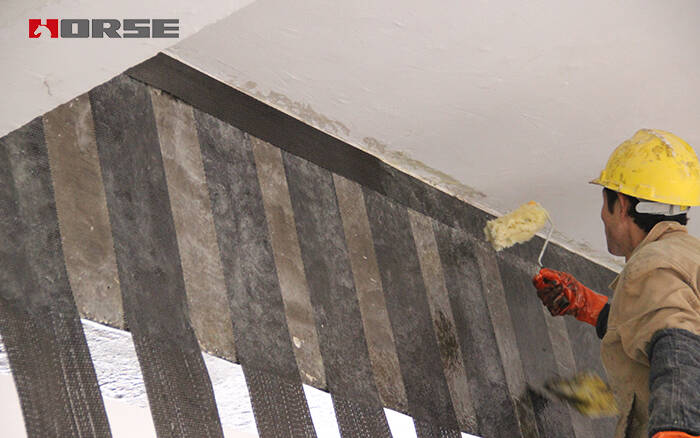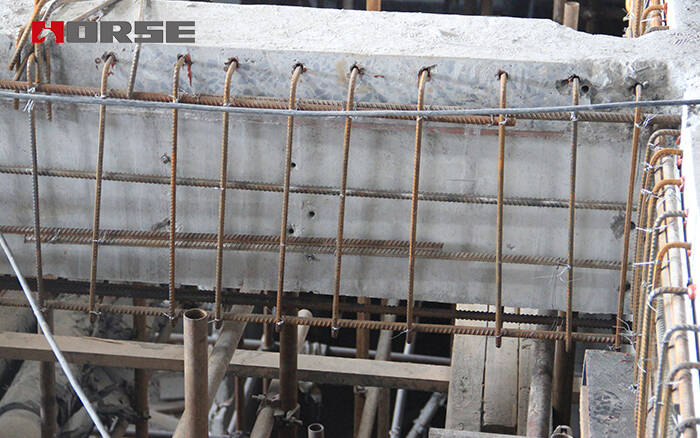Solutions
Horse Construction offers full range of structural strengthening materials with technical supports, documentation supports, products supports, project supports.
Concrete Beam Strengthening - HORSE Construction

Whether in the frame structure or in the shear wall structure, the beam is an important component. In the structure, the beam bears the load of the upper member and transmits it, and at the same time improves the integrity of the house. Among them, the frame beam also plays a role in earthquake resistance. As the load continues to increase, the beam will undergo bending-based deformation, and the beam concrete will be in a state of compression on the upper part and tension on the lower part.
When the beam bears too much load and the tensile stress at the bottom of the beam is too high, it is easy to cause insufficient bearing capacity of the beam and cracks in the concrete at the bottom of the beam. Concrete cracking not only destroys the integrity of the structure, but also invalidates the concrete protective layer and accelerates the corrosion of steel bars. In order to ensure the overall safety of the structure and eliminate potential safety hazards, the beams with diseases should be strengthening and repair in time.
Key analysis of beam strengthening and repair
The beam is a typical bending member, and there are two key strengthening directions in the strengthening and repair of the bending member: normal section strengthening and oblique section strengthening. Normal section strengthening and oblique section strengthening have different directions.
The normal section strengthening can be understood as the bending strengthening, which is mainly by improving the tensile strength of the beam and increasing the bending bearing capacity of the beam to prevent cracks caused by excessive tensile stress at the bottom of the concrete.
Oblique section strengthening is mainly aimed at the lack of shear capacity of beams. The shear capacity of the beam is insufficient, and the oblique section shear failure is extremely easy to occur. Different from the failure of the normal section, there is a reaction time before the failure, and the failure of the oblique section is brittle, and the failure signs are not obvious. Once the damage occurs, the consequences are serious. Therefore, it should be avoided in both new structures and structural strengthening.
There is a certain difference between beam strengthening and oblique section strengthening in structural strengthening. Therefore, the strengthening requirements and the strengthening direction should be determined before strengthening. Generally speaking, when the strength of the front section of the beam is insufficient and needs to be reinforced, in order to prevent the increase of the flexural bearing capacity of the front section strengthening from being too large, the damage of the beam is changed to shear damage. It is advisable to conduct oblique section shear strengthening at the same time as the bending strengthening of the normal section.

Choice of strengthening and repair method
Increasing the section strengthening method, by increasing the concrete section area and the amount of steel bars, can simultaneously strengthen the normal section and the oblique section of the beam, and improve the bending and shear bearing capacity. However, the enhancement of beams strengthened by the method of increasing the section is limited, and there are major problems. One is that it can only be used when the floor or roof allows the top of the beam to protrude, which is not suitable for most houses. Second, the use of concrete materials may cause problems to recur in a corrosive environment, and the strengthening effect cannot be guaranteed.
Carbon fiber cloth strengthening and bonded steel strengthening have similar mechanisms of action. The increase in the bearing capacity of the beam is higher than that of the enlarged section method, and it can still serve stably in a complex environment. In beam strengthening, the flexural bearing capacity can be improved by pasting carbon fiber cloth or steel plate on the bottom of the beam for normal section strengthening. The improvement of the shear capacity of the oblique section needs to be realized in the form of U-shaped hoop. Therefore, in these two methods, attention should be paid to whether the U-shaped hoop is arranged and rationally arranged, and at the same time, attention should be paid to anchoring measures to prevent peeling damage and strengthening failure.
In addition, for the long-span beams in some workshops, conventional methods of strengthening have limited effects, and prestressed carbon plates can be used to improve the structural force through active strengthening. On the other hand, when strengthening frame beams, it is also necessary to pay attention to the important role of beam-column nodes to ensure that the nodes can withstand the bending moment and shear forces transmitted by the beams after strengthening, and to prevent strengthening failures caused by priority damage to the nodes.
You can find anything here you are in need of, have a trust trying on these products, you will find the big difference after that.

High strength carbon fiber reinforced polymer (CFRP) strip / laminate / plate for structural strengthening and concrete repair

Modified epoxy resin structural perfusion adhesive, specifically for supporting adhesive bonded steel reinforcement

High strength, unidirectional carbon fiber sheet pre-saturated to form a carbon fiber reinforced polymer (CFRP) sheet used to strengthen structural concrete elements.